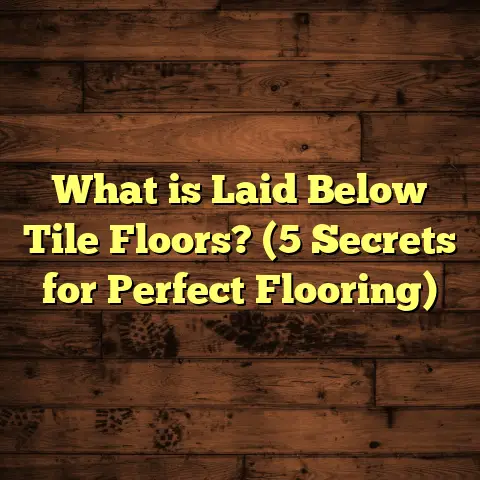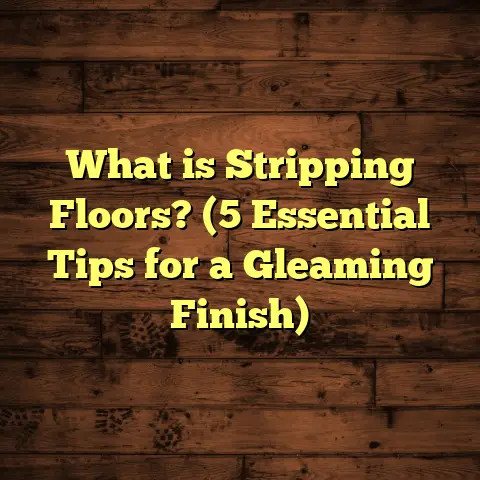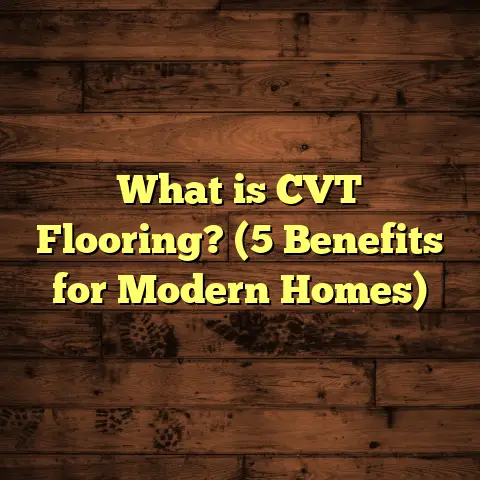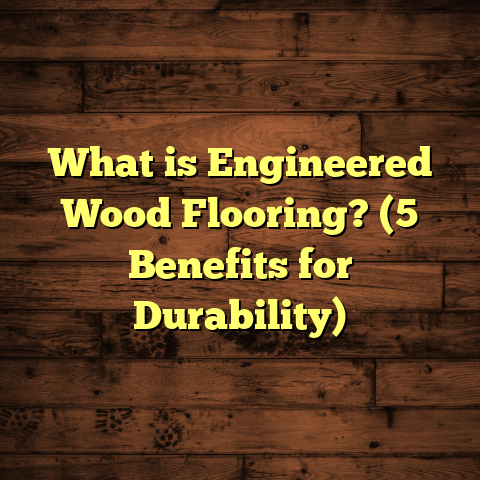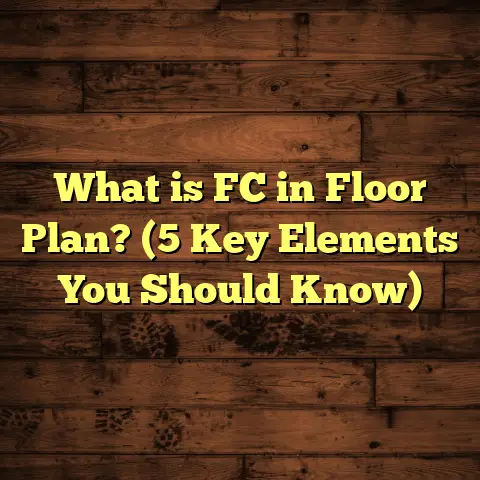What is 20 Mil Vinyl Flooring Cost? (5 Factors You Must Know)
I still remember the first time I stepped on vinyl flooring in my grandparents’ kitchen. The feel was different—soft yet tough, and it held up through decades of family meals, spills, and lively gatherings. That nostalgia always sticks with me when I talk about flooring options, especially vinyl. Over the years, I’ve worked on countless projects involving vinyl floors, and one type that often comes up is the 20 mil vinyl flooring. If you’re wondering what exactly that means, how much it costs, and what factors play into those costs, pull up a chair. I’m going to share everything I’ve learned from years in the trade and some numbers from real projects.
What is 20 Mil Vinyl Flooring?
Let’s start by breaking down what “20 mil” means in flooring terms. The word “mil” stands for a thousandth of an inch—so 20 mil equals 0.02 inches. In vinyl flooring, this term refers specifically to the thickness of the wear layer—the top transparent coating that protects the decorative layer underneath.
Why Does the Wear Layer Matter?
Imagine your vinyl floor as a sandwich. The bottom is a sturdy backing layer that supports everything. The middle is the printed design layer that gives your floor its look—whether that’s wood grain, stone pattern, or something else. The wear layer on top acts like a shield against scratches, dents, stains, and fading.
The thicker this wear layer is, the longer your floor will stay looking fresh and new. For residential use, wear layers usually range from 6 mil to 20 mil or more. Thinner layers cost less but wear out faster; thicker layers cost more but can handle heavier foot traffic and abuse.
20 Mil Wear Layer: The Balance Between Durability and Cost
In my experience, a 20 mil wear layer strikes an excellent balance for most homeowners. It’s robust enough for high-traffic areas like kitchens, entryways, and basements without carrying the premium price of commercial-grade vinyl floors which may have wear layers of 30 mil or thicker.
I’ve installed 20 mil vinyl floors in homes where kids played soccer in the hallway and pets ran around without any significant damage even after several years. It’s tough enough to take real-life challenges but still affordable for many budgets.
Construction Types: Luxury Vinyl Plank (LVP) and Luxury Vinyl Tile (LVT)
Within the 20 mil category, you’ll find two popular styles—Luxury Vinyl Plank (LVP) and Luxury Vinyl Tile (LVT). Both use similar wear layers but differ in shape and aesthetic.
- LVP mimics hardwood flooring with planks that look like wood grain. It’s great if you want a warm, natural look but need something more durable and water-resistant.
- LVT looks like stone or ceramic tile but has the comfort of vinyl underfoot. It’s often used in bathrooms or kitchens where moisture resistance is crucial.
Both can come with a 20 mil wear layer, so your choice depends on style preference and room use.
Five Factors That Influence 20 Mil Vinyl Flooring Cost
Now that you know what 20 mil vinyl is, let’s dig into pricing. How much does it cost? Well, it depends on several things—material quality, installation complexity, room size, prep work needed, and even where you live.
1. Material Quality and Brand
Not all 20 mil vinyl flooring is equal. Some brands invest heavily in research to develop advanced wear layers that resist scratches better or have UV protection to prevent fading.
For example, I’ve worked with brands like Shaw Floorte and Armstrong Luxe Plank which offer enhanced abrasion resistance and realistic textures embossed into the surface. These features push prices higher but deliver floors that last longer and look more authentic.
On the flip side, generic or budget brands might offer 20 mil thickness but use cheaper materials underneath or less refined printing technology. This can mean colors fade faster or small scratches show more easily.
Typical Material Costs:
- Budget brands: $2 – $3 per sq.ft.
- Mid-range brands: $3 – $5 per sq.ft.
- Premium brands: $5 – $7+ per sq.ft.
I once had a customer who initially went with a budget brand to save money but came back after two years saying the floor looked dull and scratched easily. We replaced it with a mid-range product with a better wear layer finish that still looked great four years later.
2. Installation Costs
Installation can sometimes be overlooked when budgeting, but it often doubles your material cost.
There are different installation methods:
- Click-lock floating floors: These are easier to install because planks snap together without glue. Labor costs usually fall between $1.50 to $3 per square foot.
- Glue-down installation: Requires adhesive and more prep work; labor costs rise to $2-$4 per square foot depending on complexity.
- Full-spread glue: Used mainly for commercial projects or high-end installations; can go above $4 per sq.ft.
The condition of your subfloor also affects labor time. Uneven surfaces require sanding or leveling before laying vinyl which adds cost.
From my projects, installation costs represented about 50% to 100% of material price depending on the space complexity. For example, a straightforward living room installation might be $2 per sq.ft., but a bathroom with lots of cuts and corners might push labor to $3+ per sq.ft.
3. Room Size and Shape
The shape of your room makes a difference too.
A perfect square or rectangle is easy for installers. Cutting planks is minimal and waste is low. Irregular rooms with many corners or alcoves require more cuts and fitting time—meaning labor costs go up.
Also, larger rooms bring economies of scale. Installing 1,000 sq.ft. usually costs less per square foot than installing 150 sq.ft., simply because setup time and fixed costs spread out over more space.
I recently completed two projects side by side—a rectangular basement family room and a hexagon-shaped sunroom. The sunroom took almost twice as long to install due to complex cuts despite being half the size, driving up per-square-foot labor costs significantly.
4. Underlayment and Subfloor Preparation
Vinyl flooring needs a smooth base to avoid bumps showing through or premature damage.
If your subfloor is concrete with cracks or wood with uneven boards, you’ll likely need preparation work:
- Leveling compounds for concrete floors
- Sanding or replacing boards for wood subfloors
- Moisture barriers in basements or humid areas
Underlayment also adds comfort underfoot and soundproofing benefits but costs extra.
I had a client who wanted vinyl over an old plywood floor with some warping. We had to replace several boards before installing underlayment and vinyl—this prep added about $1.50 per square foot but saved potential problems later.
5. Geographic Location and Market Demand
Where you live impacts prices for both materials and labor.
Urban centers tend to have higher living costs which translates to higher labor rates—sometimes double what you’d pay in rural areas.
Supply chain issues also play a role; if your area doesn’t have local distributors stocking certain brands or styles, shipping fees add up.
Based on recent data from suppliers nationwide:
- East Coast metro areas: Material + installation averages around $7 – $9 per sq.ft.
- Midwest suburban areas: Around $5 – $7 per sq.ft.
- Rural locations: Can drop below $5 per sq.ft., but product choice may be limited.
Detailed Case Studies From My Projects
To give you a clearer picture of how these factors come together, here are some real-world examples from jobs I’ve managed recently:
Case Study 1: Family Kitchen Renovation — Mid-Range 20 Mil LVP
- Location: Suburban Midwest
- Space: 250 sq.ft. kitchen + small dining nook
- Material: Mid-range LVP with textured wood grain finish
- Material Cost: $4/sq.ft = $1,000
- Installation Cost: $2.50/sq.ft = $625
- Prep Work: Minor leveling + underlayment = $300
- Total Cost: $1,925 (~$7.70/sq.ft.)
Outcome: The client wanted durability for kids’ spills but also a natural wood look without hardwood maintenance. The budget-friendly mid-range option delivered exactly that while installation stayed smooth thanks to room shape simplicity.
Case Study 2: Basement Recreation Room — Budget 20 Mil LVT
- Location: Rural South
- Space: 600 sq.ft. open basement
- Material: Budget stone-look LVT
- Material Cost: $2.50/sq.ft = $1,500
- Installation Cost: $2/sq.ft = $1,200
- Prep Work: Moisture barrier + subfloor leveling = $600
- Total Cost: $3,300 (~$5.50/sq.ft.)
Outcome: Because basements are prone to moisture, extra prep was crucial despite lower material costs. The vinyl’s thick wear layer protected against dampness damage while maintaining affordability for a large area.
Case Study 3: Small Office Space — Premium Commercial Vinyl
- Location: Urban East Coast
- Space: 150 sq.ft office space
- Material: Premium commercial-grade LVP with enhanced abrasion resistance
- Material Cost: $6/sq.ft = $900
- Installation Cost: $4/sq.ft = $600
- Prep Work: Minimal; existing commercial-grade subfloor
- Total Cost: $1,500 (~$10/sq.ft.)
Outcome: A client needed durable flooring capable of handling daily foot traffic with office chairs rolling constantly over it. The investment in premium product paid off with excellent longevity and low maintenance needs.
How Does 20 Mil Compare to Other Vinyl Thicknesses?
If you’re evaluating options between thinner or thicker wear layers, here’s how they generally stack up:
| Wear Layer Thickness | Typical Use | Durability | Price Range (sq.ft.) | Longevity (Years) |
|---|---|---|---|---|
| 6–12 mil | Light residential | Low–Moderate | $1.50 – $3 | 5–8 |
| 15 mil | Moderate residential | Moderate | $2 – $5 | 8–12 |
| 20 mil | Heavy residential/commercial | High | $3 – $7 | 10–15+ |
| 25+ mil | Commercial spaces | Very high | $5 – $10+ | 15+ |
Choosing depends on your lifestyle needs: pets, kids, activity levels all impact wear rate.
My Top Tips for Choosing and Caring for Your 20 Mil Vinyl Floor
Here’s what I tell friends who want their vinyl floor to last long without constant hassle:
Choosing Your Floor
- Look beyond thickness — check for scratch resistance ratings and UV protection.
- Match style with room use: LVT for wet areas; LVP for warmth.
- Request samples and see them in your home lighting.
- Ask suppliers about warranty coverage—good brands offer at least 10 years for residential use.
Installation Prep
- Clear furniture out completely.
- Ensure subfloor is clean, dry, level.
- Consider professional installation unless you’re confident with DIY tools.
Maintenance Routine
- Sweep regularly to remove dirt grit that scratches.
- Mop with manufacturer-recommended cleaners (usually mild soap).
- Use pads under furniture legs.
- Wipe spills immediately to avoid stains.
- Avoid wax or polish—vinyl has no need for them and buildup can damage finish.
Why I Recommend Floors with at Least a 20 Mil Wear Layer
After working on hundreds of floors over two decades, here’s my take: investing in at least a 20 mil wear layer on vinyl flooring pays off big in durability and appearance retention.
Cheaper floors might save upfront dollars but often need replacing sooner or require repairs due to scratches or fading.
On several jobs where clients initially opted for thinner options (like 12 mil), they called me back within three years requesting upgrades because of heavy wear—a costly “false economy.”
Conversely, floors with a solid 20 mil layer consistently show fewer signs of wear even after years of heavy use.
How Can You Get Accurate Cost Estimates?
Estimating exact costs yourself can be tricky without experience. That’s why tools like FloorTally are invaluable—they help calculate realistic budgets based on your location’s material prices and labor rates while factoring waste allowance.
When I consult clients early on, I often plug their project details into FloorTally or similar apps to provide transparent estimates before ordering anything.
Final Thoughts from My Experience
Vinyl flooring with a 20 mil wear layer offers an excellent combination of style, durability, and cost-effectiveness for many homeowners. It holds up well under daily life stresses while giving you enough design choices to suit any space—from rustic wood looks to sleek stone tiles.
If you want vinyl floors that won’t disappoint after just a few years but don’t want commercial-grade prices either, this thickness strikes a good middle ground.
Feel free to reach out if you want help figuring out what’s best for your project—I’m always happy to share insights from my hands-on experience!
